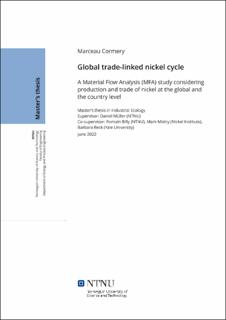| dc.description.abstract | Nickel (Ni) is a popular alloying element for stainless steel (70% of the use today). Driven by urbanization in emerging economies, its demand will keep increasing. In addition, Ni is a key element in the production of lithium-ion batteries (5% of the use today but the fastest-growing application), necessary to the electrification of the vehicle fleet. This rapid increase in Ni demand, with new geographical markets and competition for feedstocks in a context of more stringent socio-environmental regulations, could drive a burden shift of adverse impacts to less regulated locations, increase geopolitical supply risks and international tensions, but could also incentivize the use of scrap in more recently developed countries. Advising decision-makers and industrial stakeholders best on these topics requires a systemic approach, such as Material Flow Analysis. Because Ni crosses national borders many times in its lifecycle, the trade flows of the Ni cycle are an essential aspect of systemic thinking and motivate the development of a global trade-linked model. The system was analyzed at the global level, illustrating the two main supply routes, sulphide and laterite, which yield class I metal (high purity) and ferronickel/nickel pig iron (low grade). The dominance of the laterite route was emphasized. The country-level analysis revealed that a few countries dominate the total imports and exports of Ni around the world. The production and trade of laterite ore are dominated by Indonesia, the Philippines and New Caledonia, which do not retain high value-added from the operations as ores are mainly processed elsewhere in East Asia (Japan, Korea, China). The production and export of class I metal are dominated by Australia, Canada and Russia. They have plants to produce class I metal and they retain more value-added. Overall, the analysis demonstrated that none could claim itself independent among the major countries mobilizing Ni. Some countries are predominant exporters due to massive resources or important infrastructures, but they are dependent on market fluctuations. China and the EU28 are the most dependent since they combine significant Ni consumption and low domestic mining resources. Recent events such as the Indonesian export ban on Ni ore and the Russian invasion of Ukraine show that geopolitical supply risks could impact them the most. Finally, the limitations of the work were emphasized, and the study calls for better modelling of the scrap generation at the country level, increased attention on trade double-counting issues, and refining the HS code for lithium-ion batteries. Hopefully, this guidance can reduce the gaps between production and trade, strengthen the results and better support the studies on specific commodities (e.g. batteries), recycling opportunities or local socio-environmental impacts at the country level. | |
